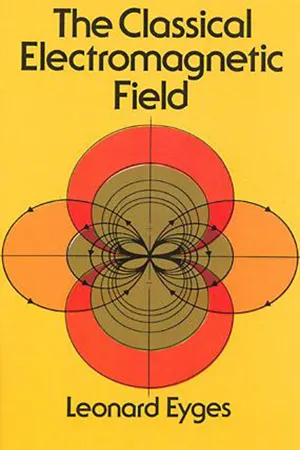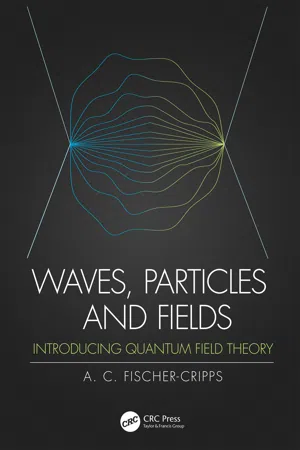Physics
Lienard Wiechert Potential
The Lienard Wiechert potential is a solution to Maxwell's equations that describes the electromagnetic field generated by a moving point charge. It takes into account the time-varying nature of the charge's motion and the finite speed of light, resulting in a non-static field that varies with both time and distance from the charge.
Written by Perlego with AI-assistance
Related key terms
Related key terms
1 of 4
Related key terms
1 of 3
3 Key excerpts on "Lienard Wiechert Potential"
- eBook - ePub
- Jerry Marion(Author)
- 2012(Publication Date)
- Academic Press(Publisher)
CHAPTER 7The Liénard-Wiechert Potentials and Radiation
Publisher Summary
This chapter discusses the ultimate sources of all electromagnetic radiation—namely, moving charges. Radiation can be produced only if a charge undergoes acceleration. There are many interesting applications of accelerating charges—the production of X-rays, the acceleration of charged particles to velocities approaching the velocity of light, the radiation from antennas, etc. If the currents are steady, the equation for the vector potential is valid. The calculation of the potential requires a retarded-time integration over the entire volume containing charge that contributes to the potential Φ. The chapter describes radiation from a charged particle confined to a circular orbit and from an accelerated charged particle at low velocities.7.1 Introduction
In this chapter we shall be concerned with the ultimate sources of all electromagnetic radiation, viz., moving charges. We shall find that radiation can be produced only if a charge undergoes acceleration. There are many interesting applications of accelerating charges—the production of X-rays, the acceleration of charged particles to velocities approaching the velocity of light, the radiation from antennas, etc. We shall study the radiation fields associated with these processes and will find a close similarity in the results. In Chapter 13 some of the results obtained here will be derived from the standpoint of relativity theory.7.2 Retarded Potentials
We found in Section 4.6 that the scalar and vector potentials could be calculated from the expressions [cf. Eqs. (4.38) and (4.39) ]In these equations we have explicitly indicated that the potentials are to be computed at a position designated by the radius vector r by integrating ρ and J throughout V by considering these quantities to be functions of the radius vector of integration r ′. The distance between the integration point r ′ and the point at which Φ and A are computed is |r’ − r′ |, and dv ′ is the volume element at r - eBook - ePub
- Leonard Eyges(Author)
- 2012(Publication Date)
- Dover Publications(Publisher)
retarded point on its trajectory. It is generally difficult to find useful exact expressions for the retarded time and approximations must usually be made to evaluate point-charge fields.14.2 LIENARD-WIECHERT POTENTIALS
The retarded potentials Φ and A of Eqs. (11.45) and (11.46) become, on using Eqs. (14.1) and (14.2) for ρ and J , and β = v/c,(14.3)In these equations the integration over dv′ goes only over the region of space where the current is (or has been) nonvanishing so that any contribution to the integrals can come only from somewhere along the previous trajectory of the particle. But as we have remarked, there is in fact only one point on the whole trajectory, the retarded point, which, for a given space time field point r, t yields a contribution. We denote the retarded point by .59 Since there is a contribution to the integrals in (14.3) only when the argument of the δ -function vanishes is defined by(14.4)For r and t fixed this intrinsic equation determines in principle, although in practice it is usually intractable. Given , Eq. (14.4) shows that the retarded time associated with it, i.e. the time at which the particle was at the retarded point, is(14.5)so that . Now is the time for the particle to get from the retarded point shown in Fig. 14.1 to its position Q at t, which point we call the present point. And is the time for light to travel from the retarded point to the field point. The retarded point is then that point on the previous trajectory for which the time for the particle to get from to Q is the same as for light to get from to P. It is easy to see qualitatively why there is only a single retarded point.60 - eBook - ePub
Waves, Particles and Fields
Introducing Quantum Field Theory
- Anthony C. Fischer-Cripps(Author)
- 2019(Publication Date)
- CRC Press(Publisher)
Somewhere out in space, there is a volume through which are oscillating electric and magnetic fields travelling together in step at the speed of light. The oscillating charge that created the field in the first place was left many thousands of kilometres behind seconds ago. Our aim is to find a way in which the E and B fields transform from one reference frame to another. We are then able to find the Lorentz invariant Lagrangian for the dynamics of the electromagnetic field and from this, determine the interaction between the field and a charged particle such as an electron. 15.2 The Scalar Potential Consider a positive charge q 2 which is moved from point A to point B in a static electric field created by q 1 located at the origin as shown in Figure 15.1 (a). We wish to compute the work done on (positive) or by (negative) the charge during this movement. FIGURE 15.1 (a) A path between points A and B taken by a charge in an electric field. (b) Position vectors for A and B. From Coulomb’s law, we have: F = q 1 q 2 u 4 π ε 0 r 2 = q 2 E (15.7) where: E = q 1 4 π ε 0 r 2 u (15.8) By definition, the electrostatic potential ϕ is the work per unit charge in moving the charge through a distance d l. The electrical potential is usually given in the units of volts. The change in electric potential is computed from the line integral from A to B along the curve C. That is, we take the sum of the dot product of E and d l along the curve. Let ∆ϕ = ϕ 2 − ϕ 1 be the change in potential from A to B. Then: Δ φ = − E ⋅ d l (15.9) As shown in Figure 15.1 (b), the vectors r 1 and r 2 are the position vectors of the two end points A and B from the origin. The change in potential is. thus: φ 2 − φ 1 = − ∫ A B E. d l = − ∫ A B q 1 4 π ε 0 r 2 u. d l = − q 1 4 π ε 0 ∫ A B 1 r 2 cos θ d l = − q 1 4 π ε 0 ∫ r 1 r 2 1 r 2 d r = q 1 4 π ε 0 1 r 2 − 1 r 1 (15.10)[. --=PLGO-SEPARATOR=--]This result shows that ∆ϕ is independent of path, but only depends on r 1 and r 2 (i.e
Index pages curate the most relevant extracts from our library of academic textbooks. They’ve been created using an in-house natural language model (NLM), each adding context and meaning to key research topics.
Explore more topic indexes
Explore more topic indexes
1 of 6
Explore more topic indexes
1 of 4


